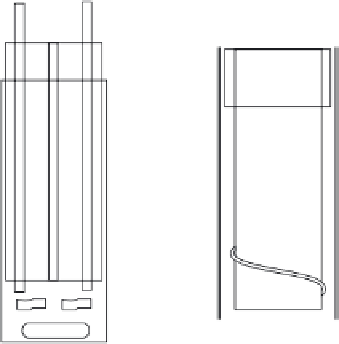Biomedical Engineering Reference
In-Depth Information
Sensor tip
Respirometer chamber
PNOS
PHSS
100 mV
electrical
insulator
stainless steel
sleeve
Pyrex chamber
PEEK stopper
platinum
wire cathode
injection port
electrolyte
tissue
platinum
anode
support
PEEK stir bar
H
2
S permeable
membrane
FIGURE 8.3
Diagram of the miniature PHSS and respirometer system. The respirometer chamber (left)
is equipped with three sensors, the PHSS and PNOS in the chamber stopper and the POS diagonal to the
chamber bottom, and has a minimum volume of 2 ml. Tissue is held on a support just above the stir bar for
adequate perfusion. The miniature PHSS (right) is approximately 5 mm long and 2 mm outside diameter. The
anode is polished at the tip, the cathode is coiled around the insulated anode, the H
2
S-permeable membrane
is cemented to the stainless steel sleeve, and the 30 µL electrolyte volume covers both anode and cathode
(after [41]).
was fi lled with the ferricyanide electrolyte. The end of the sensor contained within the
sleeve, approximately 50 mm long, was fi tted into a port of a PEEK stopper designed
for the oxygraph respirometer chamber. The stopper contained two sensor ports and
an injection port. The PHSS polarizing voltage was set at 150 mV with a multichannel
analyzer (Apollo 4000, WPI, Sarasota, FL) that also recorded sensor signals. A newer
miniature PHSS model is currently available from World Precision Instruments (model
ISO-H2S-2, Sarasota, FL).
8.4 CALIBRATION OF POLAROGRAPHIC H
2
S SENSORS
8.4.1 H
2
S stock solutions
The PHSS was calibrated with step-wise additions of H
2
S stock while positioned in
the respirometer chamber containing 3 ml stirred (500 rpm) 20 mM Tris-buffered zero-
grade argon (
0.0003 kPa O
2
) equilibrated analytical grade purifi ed water (Solution
2000, Jasper, GA), at the pH and temperature of the subsequent experiment. H
2
S













Search WWH ::

Custom Search